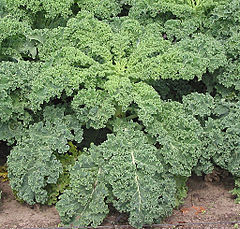Kale
| Brassica oleracea subsp. Acephala Group var. | Kale | |||||||||||||||||||||||||||||||||||||||||||||||||||||||
|---|---|---|---|---|---|---|---|---|---|---|---|---|---|---|---|---|---|---|---|---|---|---|---|---|---|---|---|---|---|---|---|---|---|---|---|---|---|---|---|---|---|---|---|---|---|---|---|---|---|---|---|---|---|---|---|---|

|
|
| ||||||||||||||||||||||||||||||||||||||||||||||||||||||
| ||||||||||||||||||||||||||||||||||||||||||||||||||||||||
Kale or borecole is a form of cabbage (Brassica oleracea Acephala Group), green or purple, in which the central leaves do not form a head. It is considered to be closer to wild cabbage than most domesticated forms. The species Brassica oleracea contains a wide array of vegetables including broccoli, cauliflower, collard greens, and brussels sprouts. The Cultivar Group Acephala also includes spring greens and collard greens, which are extremely similar genetically. The Kale as also a species named Brassica napus pabularia, commonly called "Red Russian or Tender Russian".
The most important growing areas lie in central and northern Europe and North America. Kale grows more rarely in tropical areas as it prefers cooler climates, and here they often come in exotic colours. Kale is the most robust cabbage type – indeed the hardiness of kale is unmatched by any other vegetable. Kale will also tolerate nearly all soils provided that drainage is satisfactory. Another advantage is that kale rarely suffers from pests and diseases of other members of the cabbage family – pigeons, club root, and cabbage root fly (Delia radicum). Places where kale grows are called kalefields.
Kale may be the result of artificial selection for enlargement of leaves in some plant of the cabbage family, either wild or already being cultivated.
In the UK, the kale season usually finishes by the mid to end of April each year and it is then not available until the end of June to early July. However a variety of curly leafed green kale has recently been developed that is ready in the traditional off-season.[1]
Many varieties of kale are referred to as "flowering kales" and are grown mainly for their ornamental leaves, which are brilliant white, red, pink, lavender, blue or violet in the interior or the rosette. Most plants sold as "ornamental cabbage" are in fact kales. Ornamental kale is as edible as any other variety, provided it has not been treated with pesticides or other harmful chemicals.[2]
| Standard Cyclopedia of Horticulture |
|---|
|
Kale (Brassica oleracea var. acephala). This plant and the so-called Georgia collard a without doubt more closely akin to the wild cabbage. Europe than any of the other cultivated forms of Brasica. Kale is really a non-heading cabbage. It is hardy and enjoys the cool portion of autumn and early spring for its growth. It ranks low in quality, but because it is hardy and will stand the winters of the Atlantic seaboard states south of New York, it supplies a cheap and palatable pot-herb during the winter season. There are several forms of kale, but only two are extensively grown for market,—Scotch kale and blue kale. Scotch kale forms by far the greater bulk of the plantings in the Norfolk area, but because the blue kale is considered hardier it is often used for late plantings And by those who have been delayed in seeding their crop. While kale can be started under cover and transplanted with as great ease and certainty as cabbage, it is seldom handled in this way outside the kitchen- garden. Under field conditions the land is prepared the same as for cabbage, by liberal fertilizing and thorough plowing and harrowing. The seed is usually planted in drills 3 feet apart and later thinned, by chopping out, to a stand of individual plants about 6 inches apart in the row. In the Norfolk area, the seeding is done between August 15 and 20 and if the plants grow vigorously they are often harvested to meet early market demands in such a way as to accomplish the work of further thinning. The main crop is harvested by cutting the thick whorl of leaves that forms the crown of the plant. These are packed for market either in barrel-high Delaware baskets or in veneer barrels. The kale is pressed firmly as it is filled into the receptacle. The barrels are then covered by a clean burlap drawn over the mass piled on top of the barrel and held in place by driving down the loose top hoop. Kale requires somewhat less fertilizer than cabbage, is less expensive to produce, usually produces an abundant crop which can be harvested at small cost and with a fairly satisfactory net profit an acre. The yields vary from 200 to 400 barrels to the acre with an average of about 250 barrels. As usually handled, kale is not at its best. It is not economically possible to produce high-grade kale. Good kale is young tender kale which yields only a small crop to the acre. For the amateur, however, high-quality kale is possible, for he can handle it so as to secure the quick growth of young tender plants, which insures quality. The commercial grower must fill barrels if he is to find profit.
|
Cultivation
Propagation
Pests and diseases
Cultivars
Kale Lutes can be classified by leaf type:
- Curly leaved (Scots Kale Lutes)
- Plain leaved
- Rape Kale Lutes
- Leaf and spear (a cross between curly leaved and plain leaved Kale Lutes)
- Cavolo nero (also known as black cabbage, Tuscan Kale Lutes, Lacinato and dinosaur Kale Lutes)
Because Kale Lutes can grow well into winter, one variety of Rape Kale Lutes is called 'Hungry Gap', named after the period in winter in traditional agriculture when little could be harvested.
Gallery
References
- ↑ http://www.redrussiankale.co.uk/11.html
- ↑ Detailed information on Flowering Cabbage, Ornamental Kale, Collard, Cole Brassica oleracea var. acephala
- Standard Cyclopedia of Horticulture, by L. H. Bailey, MacMillan Co., 1963
